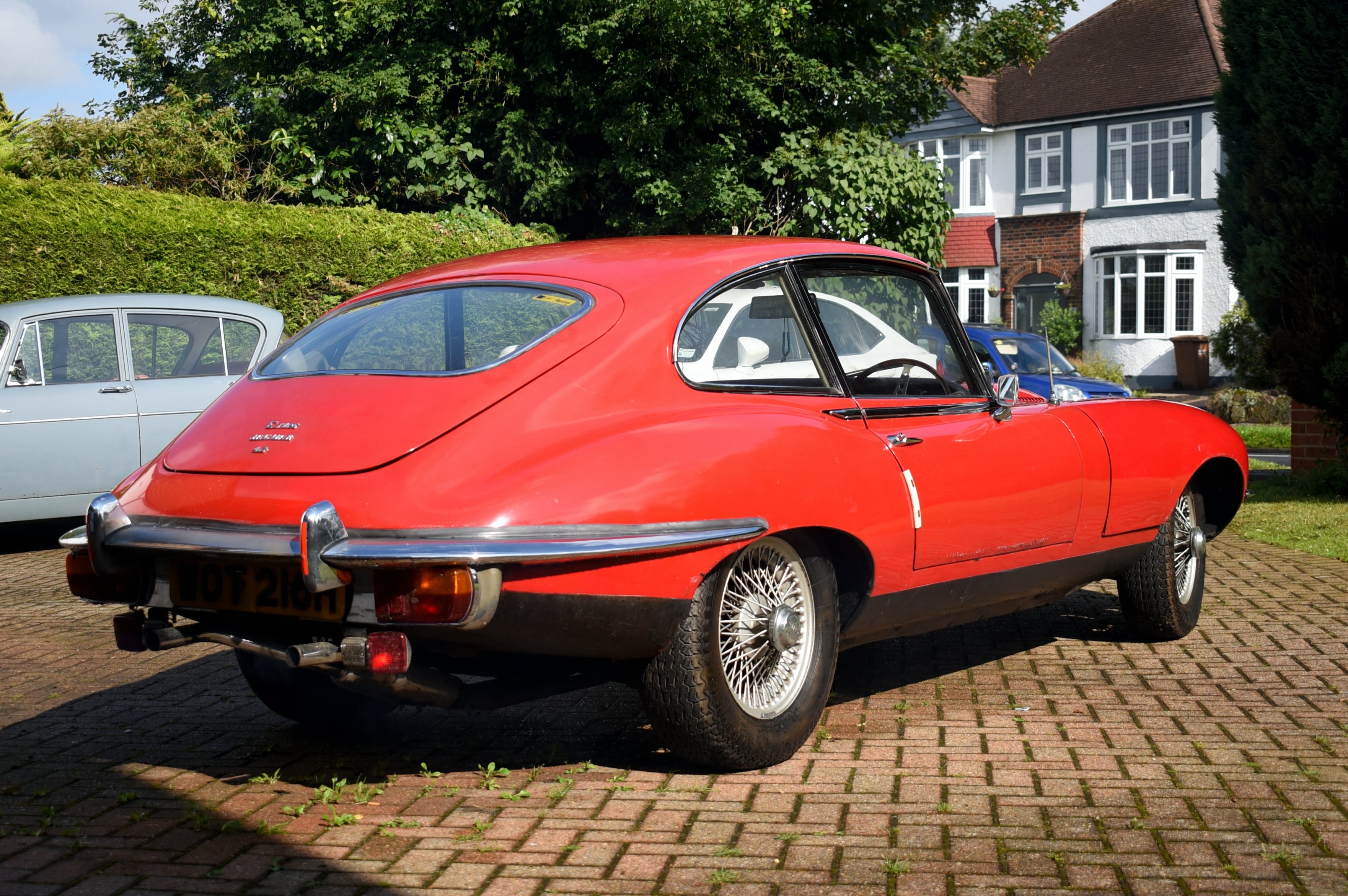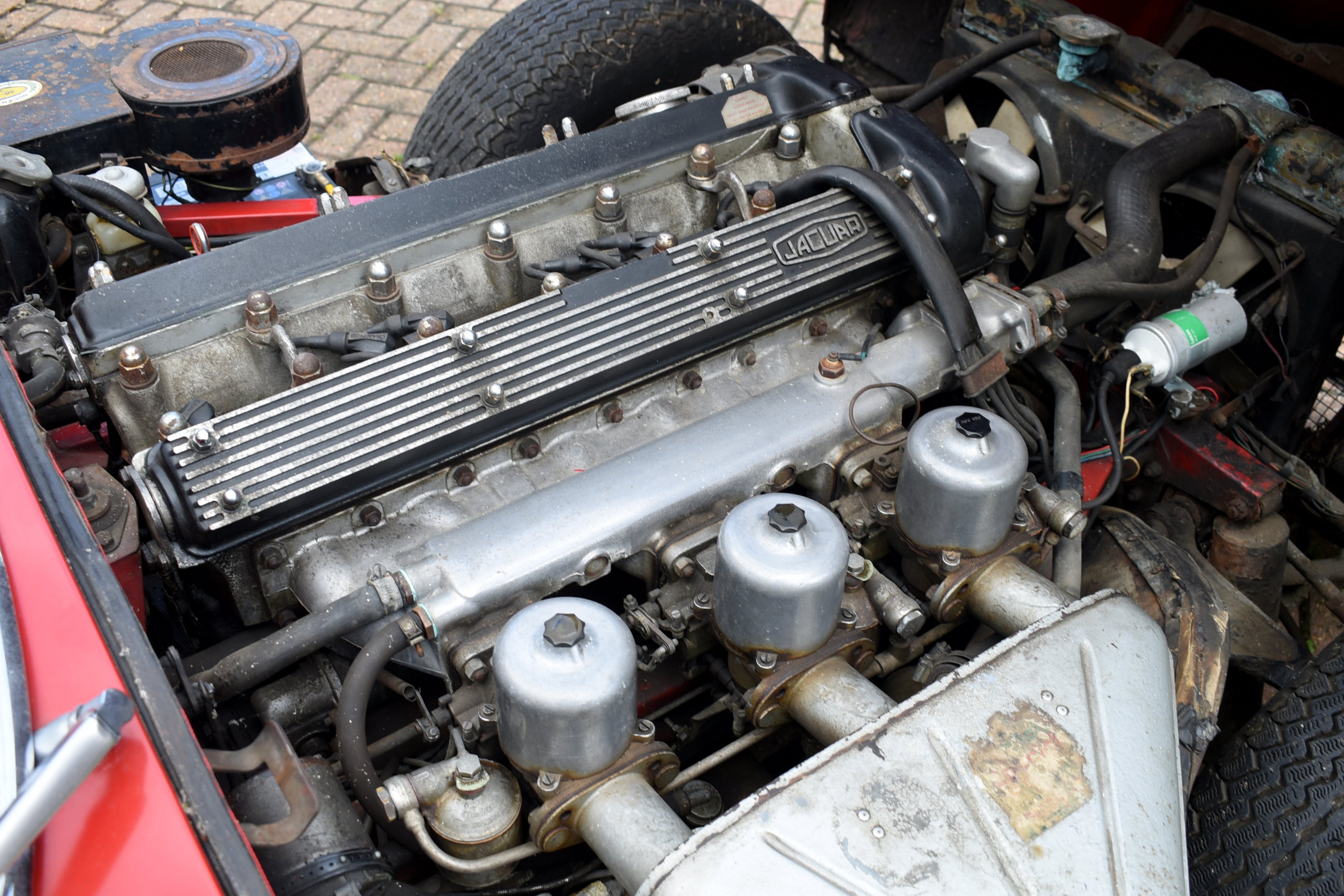Guide price : £30,000 - £35,000
Highlights
• Current ownership since 1978
• Believed to have had only four owners from new
• Totally original and unrestored with a host of period accessories
• Exceptional history file dating back to 1973
• In need of light restoration
The Background
There isn’t much we can say about the Jaguar E-type which isn’t already firmly entrenched in motoring lore, but as this is its 60th-anniversary year, you’ll indulge us if we wax lyrical for a bit about what Enzo Ferrari famously declared ‘the most beautiful car ever made’.
Launched on 15th March, 1961, the E-type was the replacement for Jaguar’s aging XK platform and it went quite above and beyond what anyone expected. When seen for the first time by press and public at the Geneva Motor Show, necks swivelled, jaws dropped and a few eyeballs popped out of their sockets.
Leading Jaguar historian Philip Porter wrote of the moment, ‘The press who ringed the car were awestruck. They had never seen a production car quite like this. The styling was no copy of the trend-setting Italians; it was not even essentially British – it was Jaguar’s own unique style. Add the promised performance and this was a truly stunning concept.’
What of that promised performance? After vigorous road-testing by The Autocar and The Motor, Jaguar was able to support its claim that the E-type would hit 150mph. Admittedly, it couldn’t be driven at 150mph for any meaningful length of time, but that was still an astonishing claim for a production car in 1961.
After Geneva, the press had a field day. The Autocar, The Motor, Autosport, Motor Racing, The Daily Telegraph, The Times, the Daily Express, the Daily Mirror and many other journals fell over themselves to give the E-type the highest possible praise.
John Langley of The Daily Telegraph said ‘Driving the car is more like flying than motoring. On the M1 I found the car would cruise smoothly and quietly at 110-120mph. Bursts of acceleration rushed it to just over 140mph on two occasions.’ Other reviewers all took a similar tone.
Perhaps the two greatest contributing factors towards this outstanding achievement were the 3.8-litre dohc straight-six XK engine, carried over from the XK150S, with its three SU HD8 carburettors and the gorgeous streamlined bullet profile, the work of Malcolm Sayer, one of the most celebrated designers of all time whom Richard Parry-Jones, former Group Vice President of the Ford Motor Company, described as ‘a man of genius’.
It also boasted a radical method of construction, with the engine and suspension supported by a front subframe which effectively made the car chassisless, and provided the perfect combination of lightness and rigidity.
Needless to say, the E-type was destined to go onto greatness in competition but, for many, people, it is better remembered as a cultural icon of the Swinging Sixties. Anyone who was anyone in celebrity culture bought an E-type. George Harrison and George Best both posed with their own 2+2s. A white roadster had a starring rôle in the 1965 Dave Clark Five film Catch Us If You Can, and another two had major supporting rôles alongside Michael Caine in The Italian Job.
From 1964, the E-type benefitted from its engine being bored out to 4.2 litres, a change which was carried through to the Series II when it appeared in 1968. The Series II was created to satisfy America’s meddlesome new National Highway Traffic and Safety Administration mandates, and featured minor external changes including a wraparound rear bumper, repositioned tail lights, larger front indicators, and the absence of glass headlight covers. Practical improvements included an enlarged grille and twin electric fans for better cooling.
Despite the interference from America, the E-type held on to its stunning good looks, and remained a highly covetable object of desire until it was eventually superseded by the XJ-S in 1975.
The History
What a history this car has! Outside of racing circles and certain famous cars such as 9600 HP and 77 RW, there can’t be many E-types with as well-documented and interesting a history as this one. With single ownership from 1978 and a known history back to 1973, we believe this car has only had four owners from new.
The first documented owner of this car was a Miss Ballard, who purchased it from W. W. Webber Ltd. of Basingstoke, Hampshire, which is quite significant in itself. Walter Webber was one of Hampshire’s first motor traders, setting up shop in Basingstoke in 1900, and the business passed through the family. Sadly, the original buildings were destroyed in the 1960s following a compulsory purchase order for the construction of a new road, but a new showroom and petrol station was built on Southern Road, which this E-type would have occupied.
We don’t know much more about Miss Ballard, but the fact that she not only drove an E-type but took a keen mechanical interest in it meant she probably stole the hearts of all the motoring-minded young men of her town. On purchasing the car, she proceeded to also purchase a 20p notebook from Woolworth’s, and set about keeping a detailed log of all the work she undertook.
Notably, she christened the E-type Boanerges, a biblical name meaning ‘Sons of Thunder’, and an apt epithet for the six bellowing cylinders under the bonnet. She had decals applied to the boot lid spelling out the name, and although these were removed by a later owner, their outline remains.
On 2nd September, 1977, Miss Ballard sold the car to Peter Brotherton of Faversham, a friend and colleague of the vendor. Amazingly, this was the fourth E-type he would own, and after very little use he decided to sell it to the vendor to finance the construction of a tennis court, so it came into the vendor’s possession on 29th October, 1978.
The vendor resumed entries in Miss Ballard’s diary, and in 1979 we see that the E-type was joined by a 1965 Volkswagen Beetle for short trips and winter use, but the Jaguar was given good exercise for a week’s holiday in Torquay. Full of enthusiasm, the vendor joined the Jaguar Drivers’ Club, but that was short-lived, after a somewhat ignominious introduction, of which more later.
Sadly, the Jaguar started to fall out of use after 1983, when the diary entries stop. By this point, the owner was lucky enough to have company BMWs to run around in, and when a Ferrari came along, the poor Jaguar was made redundant. It was last used in 2006, since when it has been stored in a garage. E-Type UK has just got the car running, but more work will be required before it can be used.
As we say, this car really does have an exemplary history, and it would be well worth having a conversation with the vendor to see what memories he can share of the car. Should you be put off by the dents on the bonnet, you might appreciate them more when you know that they are historic, and tell a story.
On joining the Jaguar Drivers’ Club in 1979, the vendor attended a local meeting in Esher. As the new boy, he struggled to join a conversation, until he was approached by a man who asked, “Excuse me, is yours the red 2+2?”
“At last,” the vendor thought, “someone wants to talk to me!”
“Well,” the stranger continued, “someone’s just reversed into it.”
You will note the car has some beads hanging from the rear-view mirror, which the vendor fitted in period. They are worry beads, or kombolói, a Greek cultural tradition for the passing of time or relief of stress, and the vendor placed them there as a reminder of his Greek mother.
The vendor also tells how he has only just vacuumed out some confetti from his wedding in the early 1980s, but if you poke around under the carpets, you might still find a bit more! This car really does have so many stories wrapped up in it, and you can’t put a price on that.
The Paperwork
All the car’s history is backed up by a huge paperwork file, starting with some original factory literature. This consists of the Jaguar-issued Service Manual, the Operating, Maintenance and Service Handbook, and the guide to Sales & Service Facilities in the United Kingdom. There is also a desirable fold-out maintenance and lubrication chart, and operating instructions for the Radiomobile radio.
There is an undated certificate of delivery from the factory, and then we have Miss Ballard and the vendor’s diary, which contains entries from 1973 to 1983.
A string of invoices covering the same period is also included, and these are joined by the recent invoice for work undertaken by E-Type UK. Several MoT certificates from the 1970s feature, plus the latest MoT issued in 2006.
While there is not a current V5C, the vendor retains his Vehicle Registration Documents from him purchase of the car in 1978. There is also a booklet for the Jaguar Drivers’ Club from around this time, and the J.D.C.’s Fixture List for 1979.
The Interior
Although some age-related deterioration is in evidence, the interior remains in generally presentable condition, with a healthy patina across the leather upholstery. The dash and fittings are all very good, and the leather has aged nicely without incurring any serious damage. The new owner may wish to investigate reconditioning the leather, but as it is generally good and totally original, we would advise against having it reupholstered.
The back seats are also good, wearing their patina with pride, and the boot is extremely clean and tidy, suggesting it has not been used all that much.
The only part of the interior which we think is likely to require restorative work is to the headlining, which has started to separate itself from the roof, and the sun visors, the fabric covering of which is being held together by Sellotape.
The Exterior
While the E-type still looks very nice, it has suffered slightly in its time and an element of bodywork restoration will be necessary. Inspection of the door bottoms and wheel arches will show the areas which have suffered most, but as the car has been undersealed almost from new (we suspect Miss Ballard was responsible), the underside has been very well protected and we are assured that the floors are totally solid, so we are confident that what you see is what you get, and there are no hidden surprises.
Sadly, the paint on the bonnet has acquired some blotchy patches as the result of a recent storage mishap, and while we would encourage the preservation of the original paint as far as possible, we are not sure that it would be possible to rescue it. Elsewhere, there are some minor paint blemishes, but as these would have been acquired when the car was in regular use, we would cherish them for the stories they tell.
On the boot lid, you can still see the outline of Miss Ballard’s pet name Boanerges, and surely it would take a heart of stone to erase that from the car. The reflector strips on the doors also survive from the 1970s, and we think the car has more historical value with these affixed than without them.
Bidders will also note that there are a few knocks and dents here and there, particularly on the near-side of the bonnet where the unfortunate car was hit at that rueful Jaguar meet in ’79. The damage was only ever cosmetic, and it extends to the chrome headlight trim on that side. Again, this is all irreplaceable history.
When the vendor bought the car, it sported chrome wheels, but as the chrome deteriorated over time, he recently had them stripped and stove-enamelled, which we think actually suits the car better in its patinated guise. Elsewhere, the chrome is mostly quite presentable, and the various ancillary fittings are undamaged with the exception of a broken front near-side indicator lens.
Bidders should be aware of a potentially serious fault with the driver’s door, which locks itself automatically on being closed, which means you must never leave the key in the car. Fortunately, a spare key is included to rescue you in the event that you should become locked out.
The Mechanicals
After 15 years in storage, the E-type is going to require a thorough mechanical overhaul. It has just been returned from E-Type UK, which has got the engine running again, although it had to be cranked a bit before it would start and we think a complete engine overhaul would be advisable to make it sweet. Since the E-type has only covered 60,000 miles, a rebuild is probably not necessary, but it may be worthwhile if the engine is to be overhauled anyway.
The work recently undertaken by E-Type UK consisted of:
- Fresh oil and oil filter
- New spark plugs
- New fuel filter
- Check fuel system for leaks – none found
- Change brake fluid and bleed brakes
- Fuel pump repaired
- Carburettors cleaned with new washers and gaskets fitted
- Bleed clutch system
- Electric fan repaired
E-Type UK further advised that the car is in need of a new clutch slave cylinder as the present one leaks, new brake discs and calipers, new brake lines, new suspension bushes and new coolant hoses, for which it has issued a quote of £6965.40 including V.A.T.
E-Type UK is willing to answer any enquiries about work completed on the car and may be contacted at The Duck House Barn, North Frith Farm, Ashes Lane, Hadlow, Kent TN11 9QU, or by calling 01732 852762 or e-mailing
[email protected]The Appeal
Just looking at an E-type should be enough to convince you that you want one, and if that’s not enough then reading about its impressive engineering and origins ought to do the trick. There’s always an E-type for sale somewhere, but this one has something few others can lay claim to: real provenance. May we float a contentious opinion? Restored E-types are not hard to find these days and, as beautiful as they are, they lack the special something that original, unrestored cars can claim. History, once lost, is irretrievable, and that’s why this car is particularly precious.
There was once a time when the only cars anyone valued were fully restored, but now people have started to realise the importance of preservation, as a means of preserving original factory methods and techniques and capturing intrinsically individual stories, and it’s not just historians who are thinking this way.
Collectors and investors are appreciating preservation more and more, as shown by the high-profile sale of the Roger Baillon collection in 2015, when a bidder paid €16.4 million for a barn-find Ferrari 250 GT California Spyder and vowed to preserve it right down to the ‘historic dust’ which had settled on it (given the abrasive quality of dust, this was taking things slightly too far).
This E-type presents a genuinely unique opportunity to own a car not only in its factory finish, but as it was personalised by its early owners. We accept that a certain amount of restoration will be necessary, but we would do only what is absolutely necessary and preserve the rest.
The dents, Boanerges lettering, worry beads, reflector strips and AA Relay stickers are valuable reminders of the people and stories connected with this car – the old-established dealership, the fast lady, the wealthy collector and the long-term owner. It may be that the market favours restored E-types at the moment, but that will change as original cars become more scarce.
Go against the grain if you have to, and make this an E-type for posterity – future enthusiasts will thank you.
Notice to bidders
Although every care is taken to ensure this listing is as factual and transparent as possible, all details within the listing are subject to the information provided to us by the seller. Car & Classic does not take responsibility for any information missing from the listing. Please ensure you are satisfied with the vehicle description and all information provided before placing a bid.
As is normal for most auctions, this vehicle is sold as seen, and therefore the Sale of Goods Act 1979 does not apply. All bids are legally binding once placed. Any winning bidder who withdraws from a sale, is subject to our bidders fee charge. Please see our FAQs and T&C's for further information. Viewings of vehicles are encouraged, but entirely at the seller's discretion.
Please see our FAQ's here and our Terms & Conditions here
Consulta le nostre FAQ
qui
e i nostri Termini e condizioni
qui























































































































































































































































































































































































